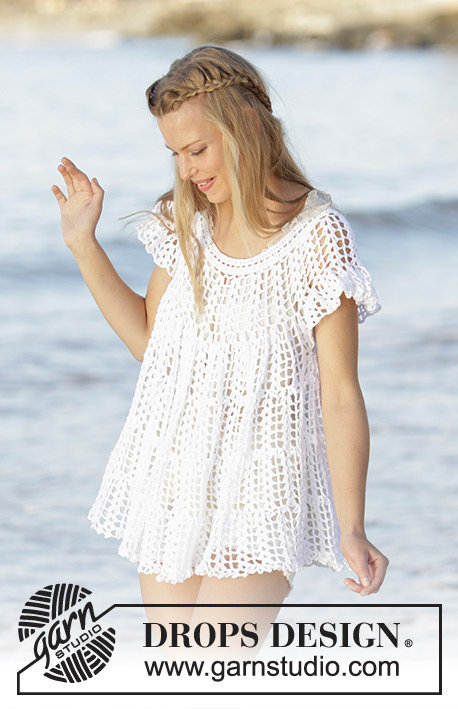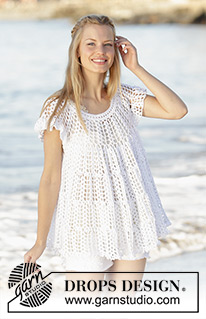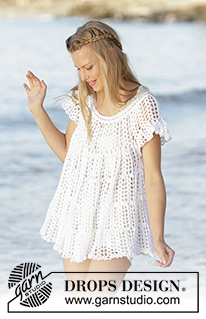Comments / Questions (151)
![]() Hanan wrote:
Hanan wrote:
Bonjour madame , comment augmenter à interval pour la taille M ? J'ai du mal à comprendre où exactement repeter les 32
07.07.2025 - 17:09
![]() Lisah wrote:
Lisah wrote:
I don’t think I quite understand after the 162 chain spaces. I have the 162 but how does that work with only 54 repetitions of A4b? Or do I switch between 4a and 4b throughout the round? Cuz if I calculate the 162 with 54 it makes 3 so I will have to use 3 spaces for one repetitions but for 4b it’s only 2 used spaces? I can’t seem to make that work with the pattern after that either. It’s gives a total other thing?
24.06.2025 - 16:45DROPS Design answered:
We saw that you got the answer from DROPS Workshop on Facebook - It's always good to ask there for at quick reply :)
26.06.2025 - 13:45
![]() Bodil Thomsen wrote:
Bodil Thomsen wrote:
Hej Hvor dejligt i vil hjælpe. Jeg hækler str s Mvh Bodil
02.06.2025 - 22:20DROPS Design answered:
Hei Bodil. Du hekler A.4a + A.4b (= 48 rapporter). På neste omgang fortsettes det videre fra 3.omgang i A.3a og A.3b. Når 4.omgang er heklet ferdig i høyden gjentas denne omgangen 3 ganger til (= totalt 6 omganger med vifter). Hekle deretter fra 2.omgang i diagrammene slik: A.4a + A.4b (= 57 rapporter, i 1 rapport er det 3 luftmaskebuer = 57 x 3 = 171 luftmaskebuer). I teksten må du "hoppe" litt ned der det står "...som forklart under og øk i tillegg 3.." Kan det være der det stopper litt opp for deg? mvh DROPS Design
10.06.2025 - 10:15
![]() Bodil Thomsen wrote:
Bodil Thomsen wrote:
Tillæg til spørgsmål fra før: jeg får meget mere end 171 luftmaskebuer !!!!
28.05.2025 - 21:40DROPS Design answered:
Hei Bodil. Se vårt spørsmål til deg under, ang. str. mvh DROPS Design
02.06.2025 - 10:10
![]() Bodil Thomsen wrote:
Bodil Thomsen wrote:
Hej Færdig med 6 vifter i A.3a og A.3b Hvordan hækler man A.3b og A.5b i bredden og hvordan kan det give 171 luftmaskebuer. Kan slet ikke komme videre efter vifterne. HJÆLP Venlig hilsen Bodil
28.05.2025 - 18:49DROPS Design answered:
Hei Bodil. Vi skal hjelpe deg så godt vi kan, men hvilken str. hekler du etter? mvh DROPS Design
02.06.2025 - 10:09
![]() Renee Daniels wrote:
Renee Daniels wrote:
Do you have the knitted pattern in this design, or something similar
08.10.2024 - 19:29DROPS Design answered:
Hi Renee, If you search for "Knitted tunic" under Free patterns (use the symbol for the magnifying glass) you will get our range of knitted tunics. Here is a link to one tunic you might like: https://www.garnstudio.com/pattern.php?id=8465&cid=19 Regards from the Drops Team.
09.10.2024 - 07:12
![]() Helle wrote:
Helle wrote:
Jeg har stadigvæk problemer med at få det til at passe med opskriften og svar. Er det muligt at få oplyst hvor mange vifter og luftmaskebuer der skal være inden aflukning af ærmegab og efter aflukningen hvor mange vifter og luftmaskebuer på forstykke og ryg? Strl. M
28.08.2024 - 17:59DROPS Design answered:
Hei Helle. Du skal ha 80 rapporter av A.3b før du deler bærestykket til erme, for -og bakstykket (1 rapport av 4.omgang av A.3b har 1 vifte og 3 luftmaskebuer). Når du har delt til erme og for -og bakstykke skal du ha 20 rapporter til hvert erme og 20 rapporter foran og 20 rapporter bak. mvh DROPS Design
02.09.2024 - 07:38
![]() Helle wrote:
Helle wrote:
Tak for hurtigt svar, MEN jeg mangler svar på hvordan jeg hækler 2 omgang i diagram A.4b. Jeg har de antal luftmaskebuer og rapporter som der skal være efter diagram A.3 og som du ogsåbeskiver i dit svar. Så det er IKKE A. 3b række 2,3,4 og 5 jeg har problemer med.
26.08.2024 - 15:38DROPS Design answered:
Hei Helle. Slik hekles 2. omgang i A.4b: 1 dobbeltstav om luftmaskebuen fra forrige omgang, 2 luftmasker, 2 dobbeltstaver om luftmaskebuen fra forrige omgang, 2 luftmasker, 2 dobbeltstaver om samme luftmaskebue som de 2 forrige dobbeltstavene og 2 luftmasker. Mvh DROPS Design
02.09.2024 - 07:34
![]() Helle wrote:
Helle wrote:
Se min tidligere kommentar. fra d.d. Vil gerne have svar på hvordan jeg hækler 54 rapporter og ikke 72 rapporter, da jeg ikke kan komme videre med tunikaen.
23.08.2024 - 12:43DROPS Design answered:
Hei Helle. Se vårt svar på ditt forrige innlegg. mvh DROPS Design
26.08.2024 - 09:33
![]() Helle wrote:
Helle wrote:
Jeg har de 162 luftmaskebuer efter aflukning af ærmer. 1 rapport er 1 dobbelt stangmaske 2 luftmasker 1 vifte og 2 luftmasker. Dvs. 81 luftmaskebuer til ryg og 81 til forstykket. Er klar over at 81:3 luftmaskebuer er lig med 27 rapporter til ryg og 27 til forstykket. MEN jeg får 36 rapporter, hvad gør jeg forkert? Går ud fra at der skal være 2 luftmaske buer imellem hver vifte og at 1 rapport er som jeg har beskrevet øverst i denne mail. Hækler str. m.
23.08.2024 - 10:08DROPS Design answered:
Hei Helle. Nei, 1 rapport av 5. omgang av A.3 = 1 stav + luftmaskebue + 1 stav + luftmaskebue + 1 stav + luftmaskebue + 1 stav + luftmaskebue = 4 staver + 4 luftmaskebuer. Du hekler 10 + 10 rapporter av A.3b over bakstykket og 20 rapporter av A.3b over forstykket = 40 rapporter av A.3 a 4 luftmasker = 160 luftmasker + de 2 luftmaskebuene du øker i 5. omgang = 162 luftmaskebuer. Deretter hekles det 54 rapporter av A.4, = 27 rapporter av A.4 på bakstykket og 27 rapporter av A.4 på forstykket. mvh DROPS Design
26.08.2024 - 08:40
Lizzy#lizzytunic |
||||||||||||||||||||||||||||||||||||||||
 |
 |
|||||||||||||||||||||||||||||||||||||||
Tunic with fan pattern, flounce and A-shape, crochet top down in DROPS Safran. Size S-XXXL.
DROPS 176-2 |
||||||||||||||||||||||||||||||||||||||||
|
CROCHET INFO: At beginning of every round with double crochet replace first double crochet with 3 chain stitches. Finish round with 1 slip stitch in 3rd chain stitch at beginning of round. PATTERN: See diagrams A.1 to A.5. (Diagrams A.1a, A.2a, A.3a, A.4a and A.5a show how round begins and ends). INCREASE TIP 1 (evenly spaced): To calculate how to increase evenly, use the total number of stitches on round (e.g. 180 stitches) and divide stitches by number of increases to be done (e.g. 74) = 2.4. I.e. in this example increase alternately in approx. every 2nd and 3rd stitch. INCREASE TIP 2: Increase 1 double crochet by working 2 double crochet in same stitch. INCREASE TIP 3: Increase an extra chain space by working (1 double crochet and 5 chain stitches) around a chain space. ---------------------------------------------------------- TUNIC: Worked in the round, top down. Round begins mid back. NOTE! Choose your normal size. The chest measurement is wide, but the garment drapes nicely. Begin on hook size 3.5 mm/E/4 and Safran, work 180-192-202-211-221-233 chain stitches and form a ring with 1 slip stitch in 1st chain stitch. Work 3 chain stitches (= 1 double crochet) - READ CROCHET INFO, * skip 1 chain stitch, work 1 double crochet in each of the next 5 chain stitches *, repeat from *-* 28-30-32-33-35-37 more times, skip 1 chain stitch, work 1 double crochet in each of the remaining 4-4-2-5-3-3 chain stitches = 150-160-168-176-184-194 double crochet. Work from 2nd round in diagrams as follows: Work A.1a (shows how round begins and ends), work A.1b the entire round. On 3rd round work 1 double crochet in every double crochet and 1 double crochet around every chain stitch and increase in addition 74-96-104-128-136-142 double crochet evenly – READ INCREASE TIP 1 (evenly spaced) and INCREASE TIP 2 = 224-256-272-304-320-336 double crochet. Work from 2nd round in diagrams as follows: Work A.2a (shows how round begins and ends), work A.2b (= 28-32-34-38-40-42 repetitions). When 5th round has been worked vertically, repeat this round 3-3-4-5-6-6 more times (= 6-6-7-8-9-9 rounds in total with fans). Then work 6th round and increase 4-0-6-2-8-14 chain spaces evenly - READ INCREASE TIP 3 = 144-160-176-192-208-224 chain spaces. REMEMBER THE CROCHET GAUGE! Piece measures approx. 14-14-15-16-17-17 cm / 5½"-5½"-6"-6¼"-6¾"-6¾" from first chain stitch row worked. Work from 2nd round in diagrams as follows: Work A.3a (shows how round begins and ends), work A.3b (= 72-80-88-96-104-112 repetitions). When 4th round has been worked vertically, the yoke is done. Piece measures approx. 18-18-19-20-21-21 cm / 7"-7"-7½"-8"-8¼"-8¼" from neck edge and down (and approx. 28-29-30-32-33-34 cm / 11"-11½"-11¾"-12½"-13"-13½" from shoulder). Insert a marker thread in piece, NOW MEASURE PIECE FROM HERE. Work 4th round in A.3b one more time as follows: Work over the first 9-10-11-12-13-14 repetitions (= half back piece), skip 18-20-22-24-26-28 repetitions (= sleeve), work over the next 18-20-22-24-26-28 repetitions (= front piece), skip 18-20-22-24-26-28 repetitions (= sleeve), work over the remaining 9-10-11-12-13-14 repetitions (= half back piece) = 36-40-44-48-52-56 repetitions for body. Repeat 4th round in A.3a and A.3b 2 more times (= 6 round in total with fans). Then work 5th round and increase 0-2-4-0-2-4 chain spaces evenly = 144-162-180-192-210-228 chain spaces. Piece measures approx. 8 cm / 3⅛". Work from 2nd round in diagrams as follows: Work A.4a (shows how round begins and ends), work A.4b (= 48-54-60-64-70-76 repetitions). On next round continue from 3rd round in A.3a and A.3b. When 4th round has been worked vertically, repeat this round 3 more times (= 6 rounds in total with fans). Then work as explained below and increase in addition 3-0-6-1-1-4 chain spaces evenly: * Work last round in A.3b 1 time in width, work last round in A.5b 1 time in width *, repeat from *-* = 171-189-216-225-246-270 chain spaces. Piece measures approx. 18 cm / 7". Work from 2nd round in diagrams as follows: Work A.4a (shows how round begins and ends), work A.4b (= 57-63-72-75-82-90 repetitions). On next round continue from 3rd round in A.3a and A.3b. When 4th round has been worked vertically, repeat this round 3 more times (= 6 rounds in total with fans). Work next round in the different sizes as follows: Size S, M, L and XL: Work as explained below and increase in addition 20-12-0-2 chain spaces evenly: Work A.3a, * work last round in A.3b 1 time in width, work last round in A.5b 2 times in width *, repeat from *-* the entire round = 210-222-240-252 chain spaces. Size XXL and XXXL: Work A.5a, then work last round in A.5b the entire round and increase in addition 18-6 chain spaces evenly = 264-276 chain spaces. Piece measures approx. 28 cm / 11". Then work in all sizes from last round in diagrams as follows: Work A.4a (shows how round begins and ends), work A.4b (= 70-74-80-84-88-92 repetitions). On next round continue from 3rd round in A.3a and A.3b. When 4th round has been worked vertically, repeat this round vertically until piece measures approx. 33-34-35-35-36-37 cm / 13"-13½"-13¾"-13¾"-14¼"-14½". Work the last round in diagram. Tunic measures approx. 63-65-67-69-71-73 cm / 24¾"-25½"-26⅜"-27⅛"-28"-28¾" from shoulder. Fasten off. |
||||||||||||||||||||||||||||||||||||||||
Diagram explanations |
||||||||||||||||||||||||||||||||||||||||
|
||||||||||||||||||||||||||||||||||||||||

|
||||||||||||||||||||||||||||||||||||||||

|
||||||||||||||||||||||||||||||||||||||||

|
||||||||||||||||||||||||||||||||||||||||
Have you finished this pattern?Tag your pictures with #dropspattern #lizzytunic or submit them to the #dropsfan gallery. Do you need help with this pattern?You'll find 9 tutorial videos, a Comments/Questions area and more by visiting the pattern on garnstudio.com. © 1982-2025 DROPS Design A/S. We reserve all rights. This document, including all its sub-sections, has copyrights. Read more about what you can do with our patterns at the bottom of each pattern on our site. |
||||||||||||||||||||||||||||||||||||||||






























































Post a comment to pattern DROPS 176-2
We would love to hear what you have to say about this pattern!
If you want to leave a question, please make sure you select the correct category in the form below, to speed up the answering process. Required fields are marked *.